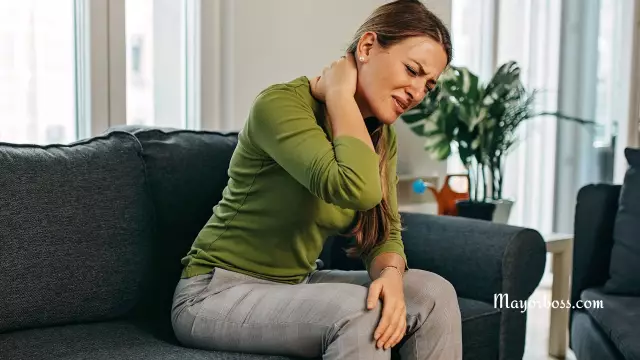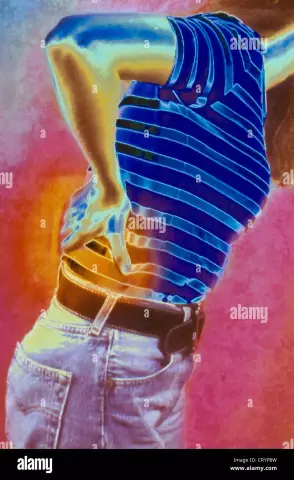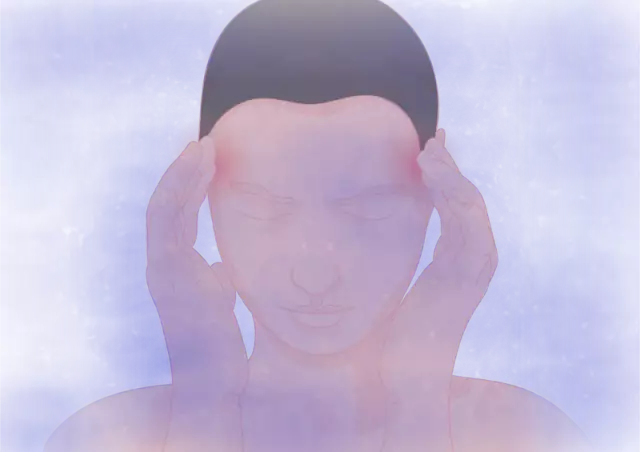- Author Rachel Wainwright [email protected].
- Public 2023-12-15 07:39.
- Last modified 2025-11-02 20:14.
Headache in the back of the head

Every person at least once in his life experienced a headache in the back of the head. The nature of this pain is different. There may be a sharp headache in the back of the head or a dull, throbbing, pressing, aching headache. The pain can be persistent or intermittent. The nature of the pain is associated with the factors that cause it. However, regardless of the cause of the headache in the back of the head, it is always quite excruciating, and a person must get rid of it. But, as you know, in order to cure a disease, you must first determine its cause.
The main causes of headaches in the back of the head
Pain in the back of the head can indicate the presence of many diseases. The most common ones are:
- neuralgia of the occipital nerve;
- diseases of the cervical spine, such as spondylitis, osteochondrosis, spondylosis, cervical migraine, etc.;
- spasm of cerebral vessels;
- increased intracranial pressure;
- hypertension (high blood pressure);
- prolonged stay in an uncomfortable position;
- stressful conditions;
- excessive muscle tension due to physical exertion;
- diseases of the temporomandibular joints or malocclusion.
The nature of the headache in the back of the head in various diseases
- Cervical osteochondrosis. This disease causes changes in the structure of the intervertebral discs and is accompanied by persistent pain in the back of the head, neck and temples. Often, painful sensations are accompanied by nausea, dizziness, hearing loss, and impaired coordination. There may be a feeling of a "shroud" before the eyes, double vision. When the head is thrown back or a sudden movement, the patient falls and loses the ability to move for some time, although he remains fully conscious. Often with cervical osteochondrosis, the patient develops a cervical migraine, which is accompanied by a sharp headache in the back of the head, extending to the temples and the superciliary area.
- Cervical spondylosis. The disease is accompanied by the appearance of bone growths on the spine, which significantly impair the mobility of the neck. At the same time, the patient experiences very frequent headaches in the back of the head, sometimes practically not stopping. With any turns and tilts of the head, the pain increases. The patient's sleep is disturbed due to constant pain.
- Hypertension. Often, high blood pressure is accompanied by the appearance of throbbing, frequent headaches in the back of the head. Headaches in the back of the head are often accompanied by palpitations, general weakness, dizziness, and sudden nausea.
- Cervical myositis. This disease often occurs as a result of hypothermia, injury or prolonged stay in an uncomfortable position. The main symptom is a headache in the back of the head when moving (turning or bending) the head. In this case, the pain often radiates to the shoulders, back of the head and interscapular region. This disease is characterized by asymmetry of pain, that is, on the one hand, it is more pronounced.
- Myogelosis of the cervical spine. This disease is characterized by the appearance of painful seals in the muscles of the neck, which is accompanied by dizziness and sharp headaches in the back of the head.
- Occipital neuralgia often causes headaches in the back of the head. At the same time, the pains are of a paroxysmal nature, they are given to the neck, back, ears, lower jaw. Any head movement, coughing, or sneezing will increase the pain. Patients with this disease describe the pain as "shooting".
- Vascular pain caused by arterial spasm. The patient complains of pain in the back of the head, mainly arising from movement and subsiding in a sitting or lying position. With physical exertion, pain in the back of the head also occurs due to vascular pathology. In this case, frequent headaches in the back of the head occur with increased physical exertion and are accompanied by a feeling of "goose bumps" on the scalp.
- Occupational pain. Often they occur in people who are forced to be in one position for a long time due to duty. So, professional pain in the back of the head occurs in drivers and office workers.
- Increased intracranial pressure. Mostly with this disease, the patient develops pain along the entire circumference of the head, but sometimes it is localized in the back of the head. Pain is accompanied by nausea and vomiting, a feeling of heaviness in the head. Often, these symptoms are accompanied by a sharp pain in the eyes in bright light.
- Violation of bite. If the malocclusion is not treated, then often this leads to various negative consequences, including the occurrence of a dull pain in the back of the head, which significantly increases in the evening. In this case, the pain can last from several hours to several days in a row.
Neck headache treatment
In order to prescribe adequate treatment for a headache in the back of the head, it is necessary to find out why it has arisen. To do this, the patient needs to undergo a preliminary examination, which includes an X-ray of the cervical spine.
Most often, the following specialists are involved in the treatment of headaches in the back of the head: traumatologist, neurologist, chiropractor, physiotherapy doctor, massage therapist, physiotherapist.

If the pain in the back of the head is caused by neuralgia of the occipital nerve, cervical osteochondrosis, stress, myogelosis, intracranial pressure or is of a professional nature, manual therapy and massage will effectively help.
With spondylosis and high blood pressure, hard massage is categorically contraindicated. But light self-massage can have a positive effect for any kind of pain in the back of the head.
Physiotherapy (magnetotherapy, electrophoresis, ultrasound or laser treatment) has a good effect in the treatment of headaches in the back of the head. Physiotherapy is especially indicated for spondylosis, cervical osteochondrosis, myogelosis, increased intracranial pressure, vascular pain, neuralgia of the occipital nerve.
Physical therapy will be useful for all patients with headaches in the back of the head, except for pain caused by malocclusion (only an orthodontist can help here).
Folk remedies for headaches in the back of the head
For mild headaches, the following folk remedies can have a positive effect:
- regular ventilation of the room, humidification of the air using special devices;
- hot compress on the back of the head and hot drink;
- a compress from a cabbage leaf previously wrinkled in the hands;
- a compress of chopped onions and grated horseradish;
- warm tea made from tall primrose herb or linden flowers. A mixture of herbs is also effective: meadowsweet, sage, peppermint.
For headaches in the back of the head, it is recommended to exclude the use of tobacco and alcoholic beverages, as they contribute to its intensification. For occupational pain, it is recommended to adjust the work area so that you can sit comfortably. You can also purchase an orthopedic pillow. Sleeping on it will promote maximum relaxation of the cervical muscles at night.
YouTube video related to the article:
The information is generalized and provided for informational purposes only. At the first sign of illness, see your doctor. Self-medication is hazardous to health!






